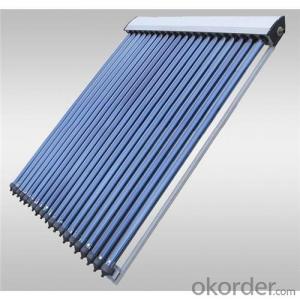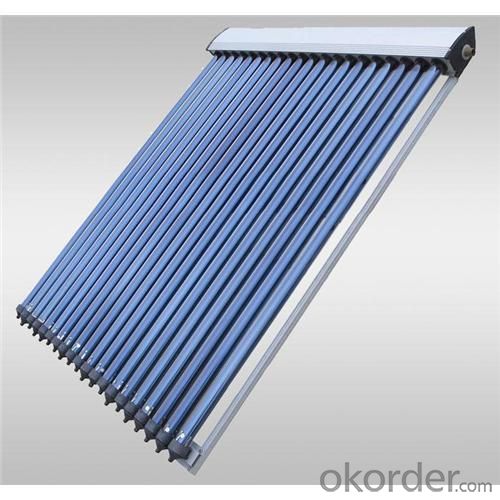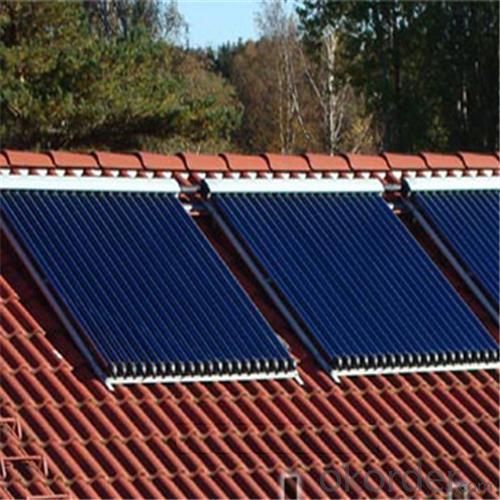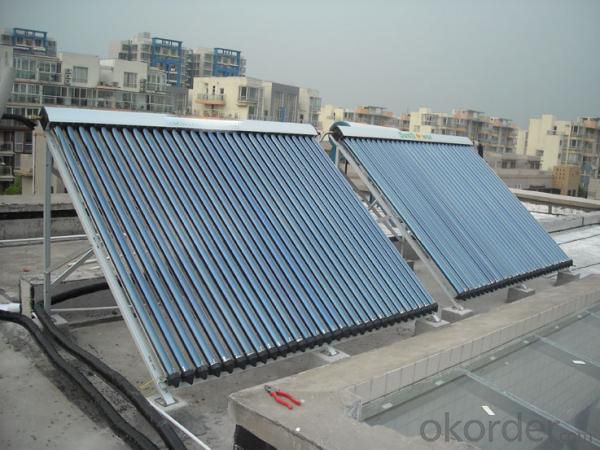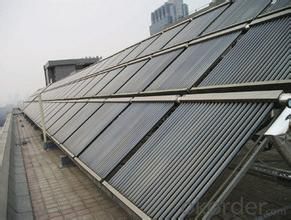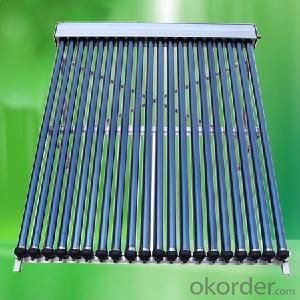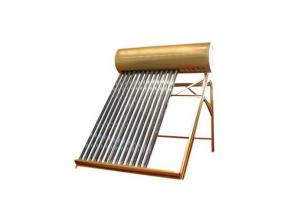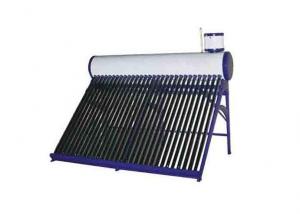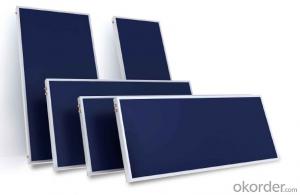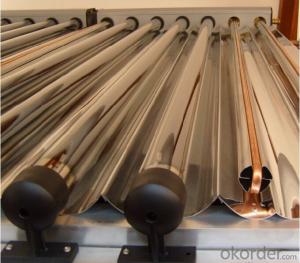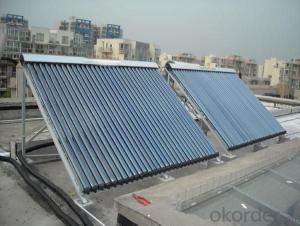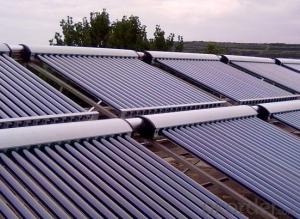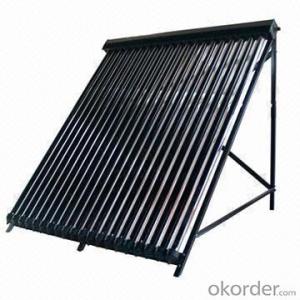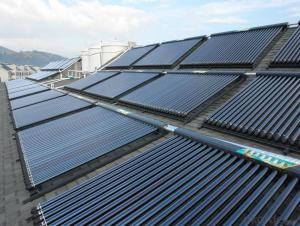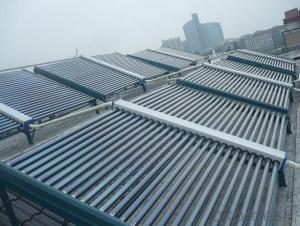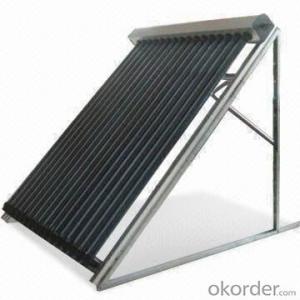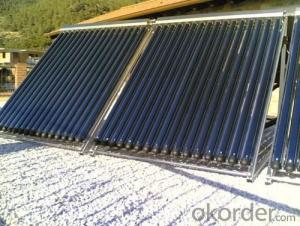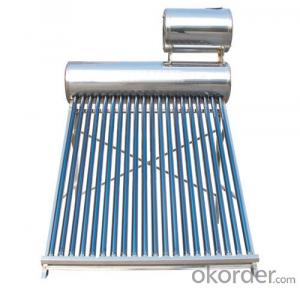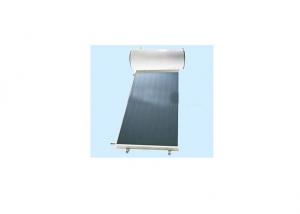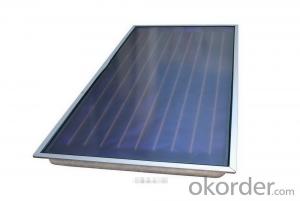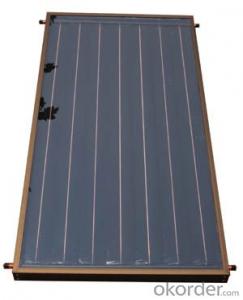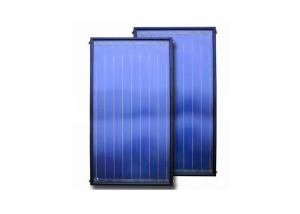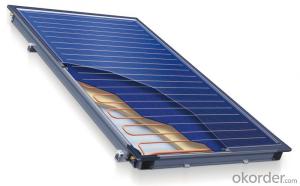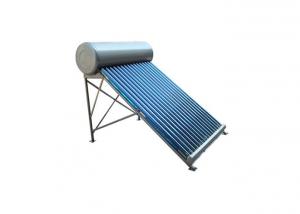Passive Solar Collectors - 20 Tubes Solar Pipes Solar Collectors EN12975
- Loading Port:
- China main port
- Payment Terms:
- TT OR LC
- Min Order Qty:
- 5 set
- Supply Capability:
- 10000 set/month
OKorder Service Pledge
OKorder Financial Service
You Might Also Like
Specification
manifold (inner) | red copper |
manifold (exterior) | aluminum alloy |
glass tube dimensions | 58mm * 1800mm |
daily efficiency | ≥55% |
heat preservation | 72 hours |
hail resistance | 25mm |
max pressure | 7 bar |
coating of vacuum tube | ALN/AIN-SS/CU |
heat pipe | anti-freezing > -35 degree |
certificate | Solar Keymark, EN12975,SRCC |
Serious Product
Models | L*W*H mm | Vacuum tube | Power output | Efficiency | Header mm | Frame | container loading 20FT/40HQ sets | Gross Weight kg |
SHC-8 | 1917*910*133 | 58*1800*8pcs | 939W | 0.668 | Φ35/1.0 | AL alloy | 185/445 | 27 |
SHC-10 | 1917*1130*133 | 58*1800*10pcs | 1189W | 159/385 | 33 | |||
SHC-12 | 1917*1350*133 | 58*1800*12pcs | 1440W | 149/358 | 40 | |||
SHC-15 | 1917*1680*133 | 58*1800*15pcs | 1815W | 120/290 | 49 | |||
SHC-18 | 1917*2010*133 | 58*1800*18pcs | 2191W | 100/242 | 59 | |||
SHC-20 | 1917*2230*133 | 58*1800*20pcs | 2442W | 87/210 | 66 | |||
SHC-22 | 1917*2450*133 | 58*1800*22pcs | 2692W | 83/202 | 72 | |||
SHC-24 | 1917*2670*133 | 58*1800*24pcs | 2943W | 77/188 | 79 |
Packaging & Delivery
Packaging Details: | Exporting Carton with big foaming protection |
Delivery Detail: | In 10-15 days |
Loading Quantity
Model | Tube | Tube Q.T.Y | Loading Q.T.Y/40HQ |
GSC15 | 58*1800mm | 15pcs | 315sets |
GSC18 | 58*1800mm | 18pcs | 265sets |
GSC20 | 58*1800mm | 20pcs | 248sets |
GSC22 | 58*1800mm | 22pcs | 225sets |
GSC25 | 58*1800mm | 25pcs | 200sets |
GSC30 | 58*1800mm | 30pcs | 168sets |
Details of solar collector:
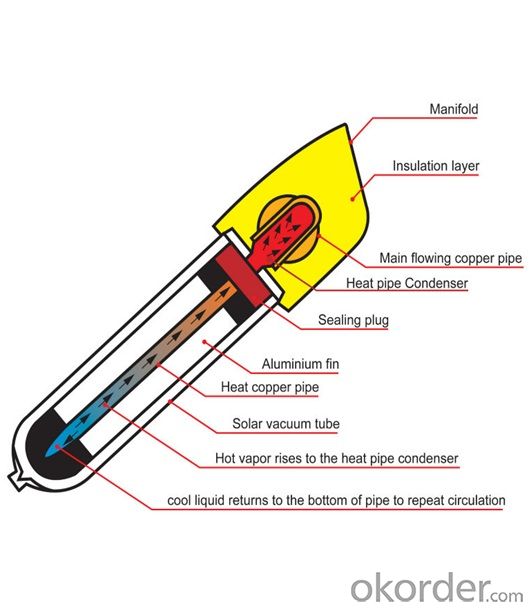
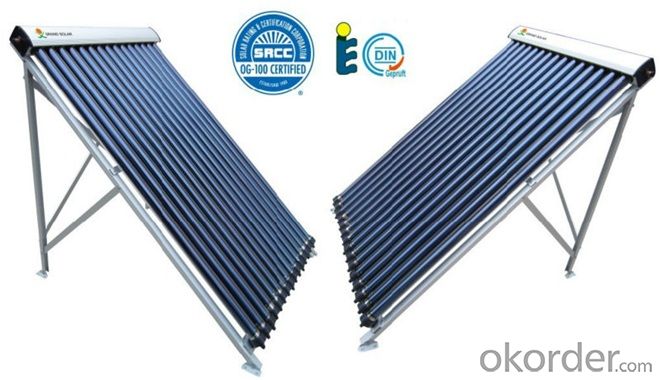

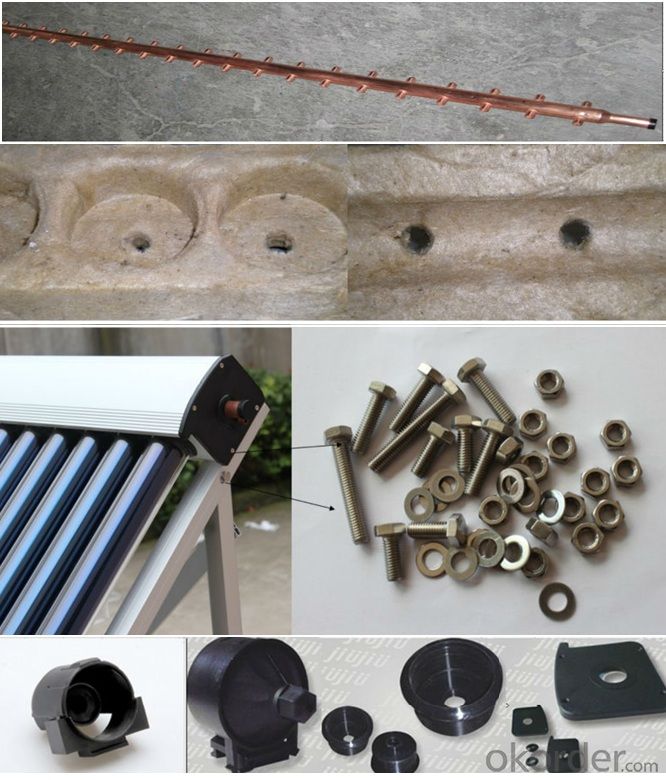
- Q: Can solar collectors be used in landfill gas-to-energy plants?
- Indeed, landfill gas-to-energy plants can employ solar collectors. These plants harness the methane gas generated through the breakdown of organic waste in landfills to create electricity or heat. As an additional energy source, solar collectors can be seamlessly incorporated into these facilities. They serve the purpose of harnessing solar energy and converting it into electricity, which can then be applied for diverse functions within the plant or fed into the grid. The amalgamation of solar and landfill gas energy sources substantially boosts the efficiency and sustainability of the plant, rendering it more eco-friendly and reducing the need for fossil fuels.
- Q: Can solar collectors be used for snow melting systems?
- Yes, solar collectors can be used for snow melting systems. Solar collectors can generate heat by harnessing the energy from sunlight, which can then be used to melt snow and ice on surfaces such as driveways, walkways, or roofs. This can be an efficient and environmentally friendly way to clear snow without relying on traditional energy sources.
- Q: Can solar collectors be used for heating zoos?
- Yes, solar collectors can be used for heating zoos. Solar thermal systems can capture the sun's energy and convert it into heat, which can then be used to warm up the enclosures and other areas within the zoo. This sustainable heating solution can help reduce the reliance on fossil fuels and lower energy costs for zoos, making it an environmentally-friendly option.
- Q: Can solar collectors be used in wave energy converters?
- No, solar collectors cannot be directly used in wave energy converters. Solar collectors are designed to capture sunlight and convert it into thermal or electrical energy, whereas wave energy converters are specifically designed to harness the kinetic energy of ocean waves. The mechanisms and technologies used in these two types of energy conversion systems are different and not compatible with each other. Solar collectors are more suitable for solar power generation, while wave energy converters are designed for wave power generation, utilizing the constant motion of the ocean to produce electricity.
- Q: How long does it take for solar collectors to pay for themselves?
- The time it takes for solar collectors to pay for themselves, also known as the payback period, varies depending on several factors. These factors include the initial cost of the solar collectors, the amount of energy they can generate, the cost of alternative energy sources, and any available financial incentives or tax credits. On average, solar collectors have a payback period of around 10 to 20 years. However, this can be shorter or longer depending on the specific circumstances. In regions with high electricity costs or ample sunlight, the payback period can be shorter, typically around 5 to 10 years. In contrast, areas with lower electricity rates or less favorable solar conditions may have longer payback periods, often exceeding 20 years. It's essential to consider the long-term benefits of solar collectors beyond the payback period. Once the initial investment is recouped, solar collectors can continue generating electricity for many more years, offsetting or even eliminating utility bills. This can result in significant savings over the system's lifetime. Moreover, solar collectors contribute to reducing carbon emissions and promoting sustainability. They provide clean energy, help combat climate change, and reduce dependence on fossil fuels. Considering these environmental benefits, the payback period becomes just one aspect of the overall value of solar collectors. To accurately determine the payback period for solar collectors in a specific situation, it is advisable to consult with solar professionals or financial advisors who can assess the local conditions, energy consumption, and available incentives. They can provide a more precise estimate based on the specific factors at play.
- Q: What is the impact of altitude on the performance of solar collectors?
- The impact of altitude on the performance of solar collectors is significant. As altitude increases, the air becomes thinner, resulting in lower air density and reduced heat transfer. This can lead to a decrease in the overall efficiency of solar collectors, as the absorption of solar radiation may be less effective. Additionally, higher altitudes often experience lower temperatures, which can further impact the performance of solar collectors. Therefore, it is important to consider the altitude when designing and utilizing solar collectors to ensure optimal performance and efficiency.
- Q: Can solar collectors be used for heating paper mills?
- Yes, solar collectors can be used for heating paper mills. Solar thermal systems can provide heat through the use of solar collectors, which capture and convert sunlight into thermal energy. This energy can be utilized for heating purposes in various industrial applications, including paper mills. By integrating solar collectors into the heating systems of paper mills, renewable energy can be harnessed to reduce reliance on fossil fuels and decrease carbon emissions.
- Q: How do solar collectors affect land use?
- The utilization of solar collectors, such as solar panels or solar thermal systems, greatly affects land usage. Unlike traditional energy sources like coal or gas power plants, solar collectors necessitate expansive surface areas to capture sunlight and convert it into usable energy. The amount of land required can vary depending on the solar collector system's type and capacity. One prevalent form of solar collectors, photovoltaic (PV) solar panels, is typically installed on rooftops or open land. When placed on rooftops, solar panels make use of existing infrastructure and do not necessitate additional land usage. However, when situated on open land, solar farms or solar parks are established, occupying significant amounts of land. The land utilized for solar collectors can have both positive and negative effects on the environment and surrounding communities. On the positive side, solar collectors generate clean and renewable energy, thereby reducing greenhouse gas emissions and reliance on fossil fuels. This contributes to the fight against climate change and the promotion of sustainable development. Solar collectors also possess the potential to reclaim or repurpose land that may have previously been unsuitable for agriculture or other purposes. For instance, solar farms can be installed on degraded or contaminated land, transforming it into productive and environmentally friendly energy-generating sites. Nonetheless, the land usage for solar collectors can also present drawbacks. Large-scale solar farms may necessitate the removal of vegetation, thereby impacting local ecosystems and habitats. Additionally, the installation of solar collectors on agricultural land can diminish available farmland, potentially affecting local food production and agriculture-based economies. To mitigate these negative impacts, careful planning and site selection are crucial. Governments, environmental agencies, and developers must consider the trade-offs and strike a balance between the advantages of clean energy and the preservation of ecosystems and land resources. This can involve initiatives such as promoting solar installations on rooftops and existing structures, implementing guidelines for land usage compatibility, and encouraging the adoption of innovative technologies that minimize land requirements, such as floating solar panels on reservoirs. In conclusion, solar collectors have a significant influence on land usage, necessitating extensive land areas for installation. While they offer numerous environmental and energy benefits, such as reducing greenhouse gas emissions and promoting sustainable development, cautious planning and consideration of potential drawbacks are necessary to ensure responsible land usage and minimize negative impacts on ecosystems and communities.
- Q: Can solar collectors be used in disaster-resilient infrastructure?
- Yes, solar collectors can be used in disaster-resilient infrastructure. They provide a reliable source of renewable energy that can be utilized even when traditional power sources are disrupted during a disaster. Solar collectors can help power critical infrastructure such as emergency communication systems, lighting, and water pumps, ensuring the continued functioning of essential services in the face of a disaster.
- Q: Can solar collectors be used in cloudy weather?
- Yes, solar collectors can still be used in cloudy weather. While the efficiency may be reduced, they can still generate electricity or heat by capturing diffuse sunlight.
Send your message to us
Passive Solar Collectors - 20 Tubes Solar Pipes Solar Collectors EN12975
- Loading Port:
- China main port
- Payment Terms:
- TT OR LC
- Min Order Qty:
- 5 set
- Supply Capability:
- 10000 set/month
OKorder Service Pledge
OKorder Financial Service
Similar products
Hot products
Hot Searches
Related keywords
